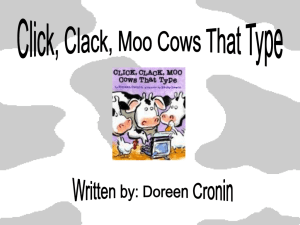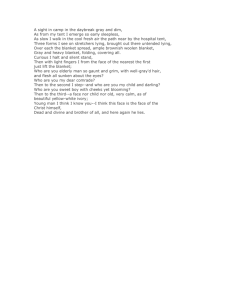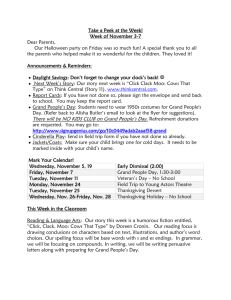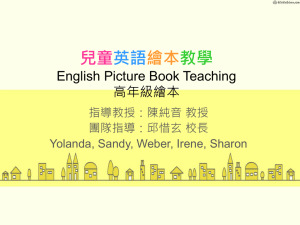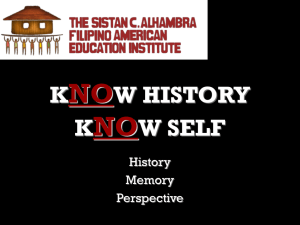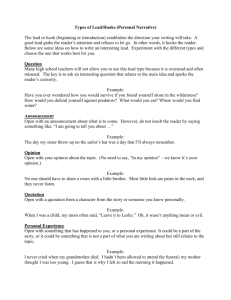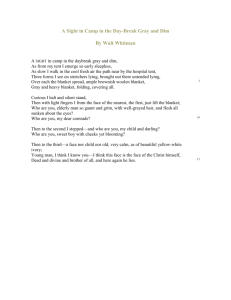Click, Clack, Moo Resource Guide
advertisement
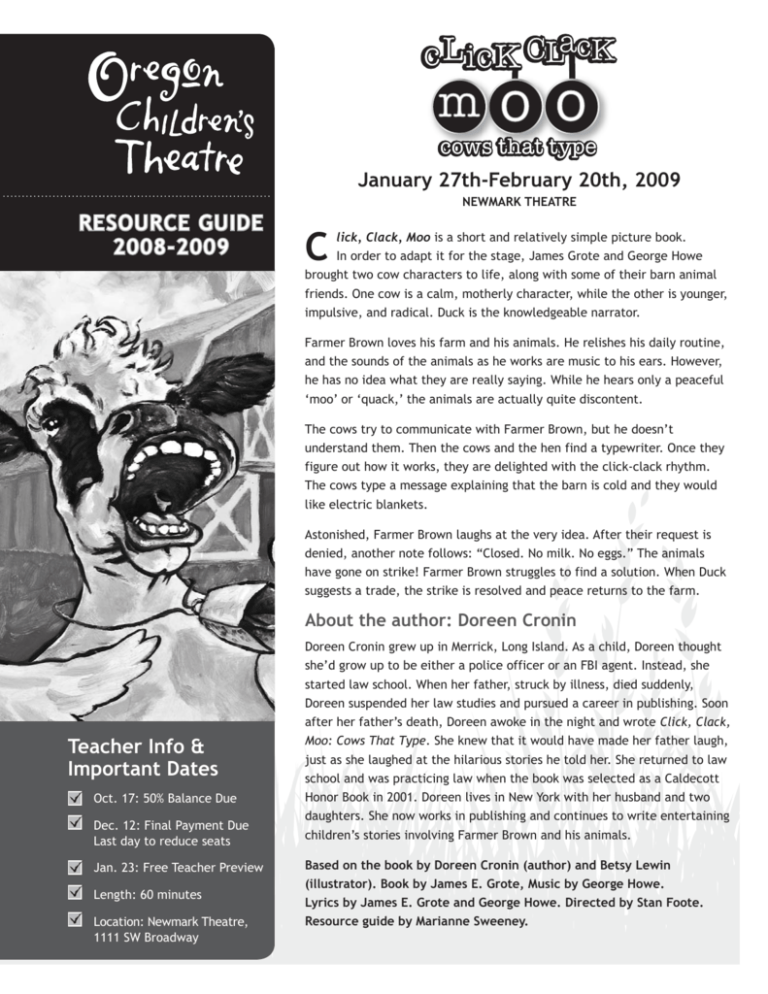
January 27th-February 20th, 2009 RESOURCE GUIDE 2008-2009 NEWMARK THEATRE C lick, Clack, Moo is a short and relatively simple picture book. In order to adapt it for the stage, James Grote and George Howe brought two cow characters to life, along with some of their barn animal friends. One cow is a calm, motherly character, while the other is younger, impulsive, and radical. Duck is the knowledgeable narrator. Farmer Brown loves his farm and his animals. He relishes his daily routine, and the sounds of the animals as he works are music to his ears. However, he has no idea what they are really saying. While he hears only a peaceful ‘moo’ or ‘quack,’ the animals are actually quite discontent. The cows try to communicate with Farmer Brown, but he doesn’t understand them. Then the cows and the hen find a typewriter. Once they figure out how it works, they are delighted with the click-clack rhythm. The cows type a message explaining that the barn is cold and they would like electric blankets. Astonished, Farmer Brown laughs at the very idea. After their request is denied, another note follows: “Closed. No milk. No eggs.” The animals have gone on strike! Farmer Brown struggles to find a solution. When Duck suggests a trade, the strike is resolved and peace returns to the farm. About the author: Doreen Cronin Teacher Info & Important Dates Oct. 17: 50% Balance Due Dec. 12: Final Payment Due Last day to reduce seats Jan. 23: Free Teacher Preview Length: 60 minutes Location: Newmark Theatre, 1111 SW Broadway Doreen Cronin grew up in Merrick, Long Island. As a child, Doreen thought she’d grow up to be either a police officer or an FBI agent. Instead, she started law school. When her father, struck by illness, died suddenly, Doreen suspended her law studies and pursued a career in publishing. Soon after her father’s death, Doreen awoke in the night and wrote Click, Clack, Moo: Cows That Type. She knew that it would have made her father laugh, just as she laughed at the hilarious stories he told her. She returned to law school and was practicing law when the book was selected as a Caldecott Honor Book in 2001. Doreen lives in New York with her husband and two daughters. She now works in publishing and continues to write entertaining children’s stories involving Farmer Brown and his animals. Based on the book by Doreen Cronin (author) and Betsy Lewin (illustrator). Book by James E. Grote, Music by George Howe. Lyrics by James E. Grote and George Howe. Directed by Stan Foote. Resource guide by Marianne Sweeney. August 2008 Dear Teacher, Click Clack Moo provides an opportunity to examine anthropomorphism and its role in understanding human behavior. Its themes of communication, the use of technology to solve problems, and relationships on farms rely on uniquely human traits. Humans use language to communicate—not only to express basic concepts but also to solve problems, discuss abstract and complex ideas, and make jokes. Scientists used to think that it was the ability to make tools that made human beings different from animals. Although we have observed chimpanzees modifying tree branches and using them as tools to dig insects out of logs, inventing is a skill that we humans cultivate and treasure in ourselves. We marvel at our ability to solve problems and improve our working and living conditions by continually inventing and using new and wonderful devices. At some point between 10,000 BCE and 8,000 BCE, humans began to grow crops and domesticate animals—therefore creating farms. In Click, Clack, Moo, Farmer Brown’s note back to the cows and Hen is a primal scream across nine millennia of husbandry: “Dear Cows and Hen, You are animals. You are supposed to do what I say! I need milk and eggs!” It is clear that Farmer Brown cannot believe that this is really happening. But we, the audience, are happy to go along with the joke! The sounds of Click, Clack, Moo are especially entertaining to us because cows, hens and ducks really don’t do what humans do. Animals don’t use language to communicate, they don’t invent and use inventions, and they don’t communicate with each other and humans to solve problems and improve their own living and working conditions. A story in which they do those things is silly. Silliness is great fun. The only thing better than being silly is being silly in a rhythmic way—Click, Clack, Moo; Click, Clack, Moo; Click, Clack, Quack! Best, Marianne Sweeney Oregon Children’s Theatre Click, Clack, Moo: Cows That Type The Big Ideas •Communication only happens when both parties hear and understand each other. •Stories about animals and people can help us understand truths about human behavior. •It is difficult to accept and understand the unexpected or the impossible. •Change is possible when people work together and cooperate with one another. Supplemental materials are available at www.octc.org/resourceguides. Your Pet Speaks… Then Writes! Target Grade Level 1-3 Activity Instructions Educational Standards Day before (10 minutes) Lesson Overview Students make a puppet that represents either their own pet or someone else’s. Students meet in groups with their puppets. The puppets have a conversation about living conditions and other topics of interest. Drawing on this discussion, the “pets” decide whether they need to write a note to their owners. They write a note together asking for things they need/want. Length of Lesson 60 minutes Learning Objectives •Students follow directions. •Students verbalize and evaluate living conditions from their pet’s point of view. •Students compose notes to post from their pets. Materials Needed Bulletin board with individual pictures of each student and room for pet pictures and notes A classroom set of paper lunch bags Lined paper for writing notes Photocopier that can shrink or enlarge Animal outline drawings size 3 1/2” x 5 1/2” (to fit on the bottom of a standard lunch bag) of several different kinds of pets: generic dogs, cats, fish, turtles, lizards, newts, birds, etc. Note: Each child will need 2 copies of the same picture. One picture is for the puppet; the other is for the bulletin board. Make more pictures of dogs and cats than other animals. These will be simple puppets. The picture of the animal will just be glued to the base of the bag, so that children may put their hand in the bag and create movement when their animal is speaking. No effort to make the mouth of the pet appear to move is intended. Oregon Children’s Theatre 1. Invite students to select a pair of matching pictures to represent either their own pet or a pet they know. 2. Instruct students to take the pictures home, color them, and bring them back the next day. E:COMM:SPK E:COMM:LST E:W:COMM E:W:AP Next Day 3. Select a picture of your own pet and glue it to the bottom of a lunch bag, making your own lunch bag puppet to show them how it is done. 4. Give students time to glue one of their pictures to the bottom of a lunch bag, making a puppet (10 minutes). 5. Brainstorm all the topics that the pets might discuss, listing these topics on the board or chart. 6. Use your own lunch bag puppet and model talking briefly about one of the topics, e.g. “I am Amarillo, the goldfish. I like living in the bowl on the counter in the kitchen because I get to watch the dishes being washed…” 7. Put students in groups of three. 8. Instruct students to give voice to their pet-puppets in a conversation about where and how they live. The list of topics will help them remember what to discuss (15-20 minutes). 9. After giving students time for their puppet conversations, distribute note-paper. 10.Instruct students to write notes from their pets. Some second and third grade students may write these notes on their own, rather than in a group (15 minutes). 11.Direct students to post their notes and their remaining picture on the bulletin board next to the pictures of themselves. Click, Clack, Moo: Cows That Type Why Electric Blankets? Target Grade Level 1-3 Lesson Overview Adapted from: www.teachernet.com •Students observe appropriate record-keeping (teacher models this). Educational Standards Students compare a regular blanket with an electric blanket to determine why the cows and hen requested electric blankets in the play. The teacher models data gathering and record keeping on a chart. This chart becomes a reference for future work in science. •Students will then feel the difference between the regular blanket and the electric blanket for themselves. Length of Lesson •Students will contribute to a class chart describing the experiment. 25 minutes Learning Objectives •Students will observe the difference between the heat of a regular blanket and an electric blanket. •Students gather information using simple equipment and tools. SC:SI:CP SC:SI:A&I •Students will learn a model for future science investigations in the classroom. •Students will collect data from an investigation. •Students will analyze data and interpret results. •Students will use the data collected to explain the results, presenting a conclusion. Materials Needed Table and chairs Electric outlet close to one end of the table (Place chair at the other end) Regular blanket Electric blanket Insta-Read cooking thermometer that reads temperatures from 0-220 degrees Fahrenheit Chart paper to describe the experiment, on which the teacher has written: •Question: Why did the cows ask Farmer Brown for electric blankets? •Observation: Compare temperatures under a regular blanket and an electric blanket. Investigation Plan Extension Data: Blanket Electric Blanket 5 min. ____degrees F _____degrees F 10 min. ____degrees F _____degrees F 15 min. ____degrees F _____degrees F Conclusion: Activity Instructions 1. Place a regular blanket on a table. 2. Invite a student to sit at the table and place his/her hand palm down on the table, under the blanket. 3. Note and record the time. 1. Use two electric blankets, two regular blankets, and two quilts. 2. Set up a third and fourth station with an electric blanket and a regular blanket, each under an insulating quilt. 3. Record temperatures at 5 and 10 minute intervals. 4. Determine whether the insulated electric blanket provides more heat than an insulated regular blanket. 5. Write a class letter to the cows suggesting that they ask for both electric blankets and quilts. 4. Discuss the play and ask students why they think the cows and the hen requested electric blankets rather than regular blankets. 5. Plug in an electric blanket and place it at the other end of the table. Repeat steps 2 and 3. 6. Use the Insta-Read thermometer to measure the temperature of the child’s hand under the regular blanket. Record the temperature on the board or on a chart along with the number of minutes that have passed since the child first put his/her hand under the blanket: e.g. 99 degrees 5 min. 7. Measure the temperature under the electric blanket. Record the temperature on the chart. This isn ’t just a bout ele blanket ctric s. It’s a bout fre Freedom edom. from Fa rmer Br tyranny own’s . Freedo m from oppress our ors. Fre edom fr the Man om !” —Cow 8. Measure the temperature of the child’s hand under each blanket at the same intervals (10 minutes) and record. 9. Ask the students to tell you what this activity demonstrates. 10.Write a conclusion on the chart: e.g. “Electric blankets are twice as warm as regular blankets.” 11.Allow all the students a chance to feel the warmth of a regular blanket and compare it to the warmth generated by the electric blanket. Oregon Children’s Theatre Click, Clack, Moo: Cows That Type Food From the Farm Target Grade Level 2-3 Lesson Overview Teacher will demonstrate the connection between food that we eat and farming. Students will see the range of products grown and raised in Oregon. Then students will sort and categorize different vocabulary words associated with farming. Length of Lesson 30-40 minutes Learning Objectives •Students will see the variety of foods we need to be healthy. •Students will understand that farmers in different parts of Oregon grow different foods and crops. •Students will sort words related to farming into different categories. •Students will demonstrate concept development by labeling these categories. 3. Explain that many of these good foods are grown and produced right here in Oregon. 4. Show/distribute the Food Grown in Oregon handout. Educational Standards E:R:VOC 5. Explain that the lines in the Oregon map show the different counties in Oregon. 6. Ask where Farmer Brown’s farm may have been located if it had existed in Oregon. (Dairy products are shown along the coast in Tillamook County.) 7. Distribute the Farming Words and Category Boxes student pages. 8. Explain that when students group words together for a good reason and then label the groups, they are building concepts. This is a basic step in building thinking skills. 9. Help the students begin this process and then let them finish on their own. Materials Needed Download the following from octc.org: Did you know…? •My Pyramid for Kids handout from the USDA (one for every pair of students, or a projected transparency) In 2006, there were 39,300 farms in Oregon. •Food Grown in Oregon handout from the Oregon Agriculture in the Classroom Foundation (one for each student, or a projected transparency) Oregon has approximately 2,000 different types of soil. •Farming Words student page •Category Boxes student page Oregon has 17,100,000 acres in farmland. Oregon has three district growing areas, the Oregon coast, the Willamette Valley, and Eastern and Southern Oregon. 1. Explain that everyone needs plenty of nutritious food to eat in order to stay healthy. Oregon summers are very dry. We rely heavily on irrigation. Nearly 78% of water usage in Oregon goes for farm irrigation, compared to 40% nationally. 2. Show/distribute the My Pyramid for Kids handout and ask students what they notice. Crops account for 69% of the state’s total farm sales. Activity Instructions Livestock and poultry account for 31% of the state’s total farm sales. Supplemental materials are available at www.octc.org/resourceguides. Story Review Target Grade Level K-3 Lesson Overview After seeing the play, students review the important elements of the story by matching pictures of the characters with phrases. Length of Lesson 25 minutes Learning Objectives •Students will recall the characters and plot of the play and demonstrate their knowledge by matching the appropriate phrases with each character. Materials Needed Download the following from octc.org: •Story Review Sentences •Story Review Picture Page •Story Review Key Scissors (class set) Glue sticks (class set) Activity Instructions 1. Distribute the Story Review Sentences sheet and the Story Review Picture Page, along with scissors and glue sticks to each student. Educational Standards E:R:VOC E:R:INFO E:R:LIT 2. Explain that each phrase on the Story Review Phrases sheet might have been said by one of the characters on the Picture Page. 3. Have students cut out sentences from the Story Review Sentences sheet, and paste them into the box on the Story Review Picture Page that corresponds with the correct character. 4. At the end of the activity, all the phrases on the first sheet should be glued into one of the boxes on the second sheet. 5. Point out that some phrases are repeated on the Story Review Phrases sheet because more than one character might have said them. Modifications 1. For students who have fine motor difficulties, it may be appropriate to have a teaching assistant cut the phrases out and put them in an envelope, so that the student’s time is used for sorting and gluing. 2. For students in K-1st grade, instead of having the students glue the sentences onto the sheet, you may print the Story Review Picture Page onto card stock and cut into four small cards. Give each student a set of the four cards. As you say each sentence aloud to the class, have the students hold up the card of the character who said it. Click, Clack, Moo: Cows That Type Communication & Inventions Click, Clack, Click, Clack, the rhythm of inventiveness, the sounds of communication. Teacher to Teacher: The typewriter was one of the great inventions of the 19th century. If you are planning a science or social studies unit on inventions, Click, Clack, Moo will provide a great literary arts connection. —Marianne Sweeney Computer projector to show online images and sounds to the entire class Educational Standards Presentation lesson only Active internet connection Map of the United States in 1803, including the Louisiana Purchase: www.earlyamerica.com Target Grade Level Sound sample of a typewriter: www.freesound.org 1-4 Excerpt from Leroy Anderson’s The Typewriter Lesson Overview This presentation lesson is designed to give students information about the human need to communicate and invent in the 19th century by looking at three important inventions: the copy press, the polygraph, and the typewriter. Students will also experience how the sound of the typewriter was an important part of the 20th century in both music and film. This presentation may be used to introduce an active unit on inventions. Length of Lesson 15-20 minutes Learning Objectives •Students will become aware of the efforts in the 18th and 19th centuries to make writing and communication easier. •Students will be introduced to these inventions: the copy press, the polygraph, and the typewriter. •Students will hear the sound of a typewriter and hear the orchestral music based on this sound by Leroy Anderson. •Students will enjoy the pantomime performed by comedian Jerry Lewis to this music. Materials Needed Download the following from octc.org: •The Copy Press and the Polygraph (picture and information sheet on both inventions) •Typewriter picture •Close-up of Typewriter Keys picture •The typewriter is the solo instrument in Anderson’s famous composition, The Typewriter, written in 1950. A brief MP3 excerpt is available on LeRoy Anderson’s official website: www.leroyanderson.com Jerry Lewis pantomiming to Leroy Anderson’s The Typewriter in the movie, Who’s Minding the Store? (2 minute excerpt) www.youtube.com Lesson Instructions 1. Show students the Map of the United States in 1803, including the Louisiana Purchase. Explain that Thomas Jefferson was the President of the United States at this time. Even back in the 1700s, Thomas Jefferson had a copy press that he used to make copies of letters by pressing them against fresh pieces of tissue paper. He even had a portable one for travel purposes. 2. Show students the picture of the copy press. 3. Thomas Jefferson also purchased a writing machine that copied his own letters as he wrote them. It was called a polygraph. 4. Show the picture of the polygraph. 5. Explain that there were many scientists all over the world in the 1800s who worked with mechanical devices, trying to invent machines that would make life more convenient. There were no computers or photocopiers, so office work was very difficult and slow. Many people tried different ideas to make letters and copying letters easier. Carbon paper allowed writers to make a copy of an original as Supplemental materials are available at www.octc.org/resourceguides. they were writing. The carbon paper was placed between two sheets of paper and the writer would press hard while writing to make a good copy. 6. Show students the typewriter picture and the close-up of typewriter keys. 8. Play the sound of a typewriter for your students. (Go to the sound sample of a typewriter on the website listed in the materials. Click on the right-facing arrow just above the picture of a sound wave.) 9. Explain that the sound of the typewriter was so rhythmic that it inspired composer Leroy Anderson to write music for orchestra featuring the typewriter. Play The Typewriter on his website. 10.Explain that the sound of the typewriter and this music was what everyone thought of when they thought of working in an office. The comedian Jerry Lewis performed a pantomime to this music in the movie, Who’s Minding the Store? 7. Explain that the first typewriter was called the Sholes & Glidden Type Writer, and it was produced by the gun manufacturers E. Remington & Sons in Ilion, New York from 1874-1878. The late 19th century is often referred to as the Age of Invention. These inventors wanted to make office work easier. Oregon Children’s Theatre Click, Clack, Moo: Cows That Type Supplemental materials are available at www.octc.org/resourceguides. 600 SW 10th Avenue, Suite 313 | Portland, OR 97205-2724 | 503.228.9571 | octc.org
